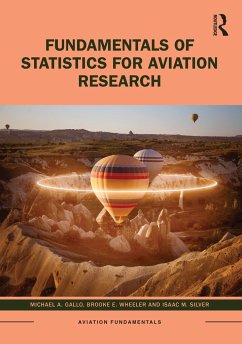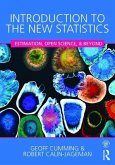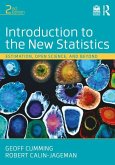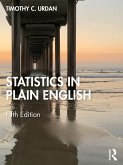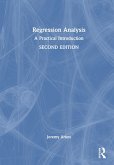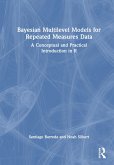Michael A. Gallo, Brooke E. Wheeler, Isaac M. Silver
Fundamentals of Statistics for Aviation Research
Michael A. Gallo, Brooke E. Wheeler, Isaac M. Silver
Fundamentals of Statistics for Aviation Research
- Broschiertes Buch
- Merkliste
- Auf die Merkliste
- Bewerten Bewerten
- Teilen
- Produkt teilen
- Produkterinnerung
- Produkterinnerung
This is the first textbook designed to teach statistics and quantitative methods to students on aviation courses. All examples and exercises are grounded in an aviation context, including flight instruction, air traffic control, airport management and human factors.
Andere Kunden interessierten sich auch für
![Introduction to the New Statistics Introduction to the New Statistics]() Geoff CummingIntroduction to the New Statistics97,99 €
Geoff CummingIntroduction to the New Statistics97,99 €![Introduction to the New Statistics Introduction to the New Statistics]() Geoff CummingIntroduction to the New Statistics96,99 €
Geoff CummingIntroduction to the New Statistics96,99 €![Statistics in Plain English Statistics in Plain English]() Timothy C. Urdan (USA Santa Clara University)Statistics in Plain English32,99 €
Timothy C. Urdan (USA Santa Clara University)Statistics in Plain English32,99 €![Design and Analysis in Quantitative Educational Research Design and Analysis in Quantitative Educational Research]() Kamden K. StrunkDesign and Analysis in Quantitative Educational Research51,99 €
Kamden K. StrunkDesign and Analysis in Quantitative Educational Research51,99 €![Design and Analysis in Quantitative Educational Research Design and Analysis in Quantitative Educational Research]() Kamden K. StrunkDesign and Analysis in Quantitative Educational Research152,99 €
Kamden K. StrunkDesign and Analysis in Quantitative Educational Research152,99 €![Regression Analysis Regression Analysis]() Jeremy ArkesRegression Analysis137,99 €
Jeremy ArkesRegression Analysis137,99 €![Bayesian Multilevel Models for Repeated Measures Data Bayesian Multilevel Models for Repeated Measures Data]() Santiago BarredaBayesian Multilevel Models for Repeated Measures Data186,99 €
Santiago BarredaBayesian Multilevel Models for Repeated Measures Data186,99 €-
-
-
This is the first textbook designed to teach statistics and quantitative methods to students on aviation courses. All examples and exercises are grounded in an aviation context, including flight instruction, air traffic control, airport management and human factors.
Produktdetails
- Produktdetails
- Aviation Fundamentals
- Verlag: Taylor & Francis Ltd
- Seitenzahl: 368
- Erscheinungstermin: 15. Juni 2023
- Englisch
- Abmessung: 244mm x 170mm x 20mm
- Gewicht: 716g
- ISBN-13: 9781032311463
- ISBN-10: 1032311460
- Artikelnr.: 67400723
- Herstellerkennzeichnung
- Libri GmbH
- Europaallee 1
- 36244 Bad Hersfeld
- gpsr@libri.de
- Aviation Fundamentals
- Verlag: Taylor & Francis Ltd
- Seitenzahl: 368
- Erscheinungstermin: 15. Juni 2023
- Englisch
- Abmessung: 244mm x 170mm x 20mm
- Gewicht: 716g
- ISBN-13: 9781032311463
- ISBN-10: 1032311460
- Artikelnr.: 67400723
- Herstellerkennzeichnung
- Libri GmbH
- Europaallee 1
- 36244 Bad Hersfeld
- gpsr@libri.de
Michael A. Gallo, Ph.D., is a Professor Emeritus in the College of Aeronautics at Florida Institute of Technology, USA. Brooke E. Wheeler, Ph.D., is an Associate Professor in the College of Aeronautics at Florida Institute of Technology, USA. Isaac M. Silver, Ph.D., is the President of Energy Management Aerospace, USA.
Table of Contents
Part A: Research and Statistics Basics
Chapter 1: The General Nature of Research and Statistics
Student Learning Outcomes
1.1 Chapter Overview
1.2 The Research Process
1.3 The Population-Sample Relationship and Sampling Error
1.4 Quantitative Research Methodologies
1.5 Variables and Measurement Scales
Chapter Summary
Vocabulary Check
Review Exercises
References
Chapter 2: Organizing and Summarizing Data
Student Learning Outcomes
2.1 Chapter Overview
2.2 Examining Distributions
2.3 Measures of Central Tendency
2.4 Measures of Dispersion
2.5 Measures of Position: Percentiles and Quartiles
Chapter Summary
Vocabulary Check
Review Exercises
References
Part B: Making Reasonable Decisions about a Population
Chapter 3: Z Scores, the Standard Normal Distribution, and Sampling
Distributions
Student Learning Outcomes
3.1 Chapter Overview
3.2 z Scores
3.3 The Standard Normal Distribution
3.4 The Sampling Distribution of Sample Means
Chapter Summary
Vocabulary Check
Review Exercises
References
Chapter 4: The Concept of Statistical Inference
Student Learning Outcomes
4.1 Chapter Overview
4.2 Parameter Estimation
4.3 The Nature of Hypothesis Testing
4.4 Hypothesis Tests Involving the Mean ( Known)
4.5 Confidence Intervals vs. Hypothesis Tests
Chapter Summary
Vocabulary Check
Review Exercises
References
Part C: Analyzing Research Data Involving a Single Sample
Chapter 5: Single-Sample t Test
Student Learning Outcomes
5.1 Chapter Overview
5.2 The t Test Statistic and t Distribution
5.3 Confidence Intervals and the t Distribution
5.4 Hypothesis Testing and the t Distribution
5.5 Using the Single-Sample t Test in Research: A Guided Example
Chapter Summary
Vocabulary Check
Review Exercises
References
Chapter 6: Examining Bivariate Relationships: Correlation
Student Learning Outcomes
6.1 Chapter Overview
6.2 Correlation Fundamentals
6.3 Quantifying Relationships: The Pearson r
6.4 Statistical Aspects of Correlation
6.5 Statistical Inferences Involving the Pearson r
6.6 Using Bivariate Correlation in Research: A Guided Example
Chapter Summary
Vocabulary Check
Review Exercises
References
Chapter 7: Examining Bivariate Relationships: Regression
Student Learning Outcomes
7.1 Chapter Overview
7.2 The Regression Equation
7.3 Statistical Aspects of Regression
7.4 Statistical Inferences Involving the Regression Coefficient
7.5 Using Bivariate Linear Regression in Research: A Guided Example
Chapter Summary
Vocabulary Check
Review Exercises
References
Part D: Analyzing Research Data Involving Two Independent Samples
Chapter 8: Independent-Samples t Test
Student Learning Outcomes
8.1 Chapter Overview
8.2 The Concept of Independent Samples
8.3 Statistical Inferences Involving Independent Samples
8.4 Using the Independent-Samples t Test in Research: A Guided Example
Chapter Summary
Vocabulary Check
Review Exercises
References
Chapter 9: Single-Factor ANOVA
Student Learning Outcomes
9.1 Chapter Overview
9.2 The Concept of ANOVA
9.3 The ANOVA Summary Table and the F Distribution
9.4 Statistical Inferences Involving the Single-Factor ANOVA: Hypothesis
Testing
9.5 Using Single-Factor ANOVA in Research: A Guided Example
Chapter Summary
Vocabulary Check
Review Exercises
References
Chapter 10: Factorial ANOVA
Student Learning Outcomes
10.1 Chapter Overview
10.2 The Concept of Factorial Designs
10.3 The Logic and Structure of Factorial ANOVA
10.4 Statistical Inferences Involving Factorial ANOVA: Hypothesis Testing
10.5 Using Factorial ANOVA in Research: A Guided Example
Chapter Summary
Vocabulary Check
Review Exercises
References
Part E: Analyzing Research Data Using a Within-Groups Design
Chapter 11: Repeated-Measures t Test
Student Learning Outcomes
11.1 Chapter Overview
11.2 The Concept of Repeated-Measures
11.3 Statistical Inferences Involving the Repeated-Measures t Test
11.4 Using the Repeated-Measures t Test in Research: A Guided Example
Chapter Summary
Vocabulary Check
Review Exercises
References
Part F: Non-Parametric Statistics: Working with Frequency Data
Chapter 12: The Chi-Square Statistic
Student Learning Outcomes
12.1 Chapter Overview
12.2 One-Way Chi-Square: The Test for Goodness of Fit
12.3 Using the Chi-Square Test for Goodness of Fit in Research: A Guided
Example
12.4 Two-Way Chi-Square: The Test for Independence
12.5 Using the Chi-Square Test for Independence in Research: A Guided
Example
Chapter Summary
Vocabulary Check
Review Exercises
References
Appendix Tables
Table 1: Area Under the Standard Normal Curve Between the Mean and z
Table 2: Critical Values of Student's t Distribution
Table 3: Critical Values for Pearson r
Table 4: Power Table for Pearson r
Table 5: Critical F Values
Table 6: Critical Values of the Chi-Square Distribution
Table 7: Sample Size and Power for Chi-Square Test for Independence
Answers to Part A Review Exercises
Index
Part A: Research and Statistics Basics
Chapter 1: The General Nature of Research and Statistics
Student Learning Outcomes
1.1 Chapter Overview
1.2 The Research Process
1.3 The Population-Sample Relationship and Sampling Error
1.4 Quantitative Research Methodologies
1.5 Variables and Measurement Scales
Chapter Summary
Vocabulary Check
Review Exercises
References
Chapter 2: Organizing and Summarizing Data
Student Learning Outcomes
2.1 Chapter Overview
2.2 Examining Distributions
2.3 Measures of Central Tendency
2.4 Measures of Dispersion
2.5 Measures of Position: Percentiles and Quartiles
Chapter Summary
Vocabulary Check
Review Exercises
References
Part B: Making Reasonable Decisions about a Population
Chapter 3: Z Scores, the Standard Normal Distribution, and Sampling
Distributions
Student Learning Outcomes
3.1 Chapter Overview
3.2 z Scores
3.3 The Standard Normal Distribution
3.4 The Sampling Distribution of Sample Means
Chapter Summary
Vocabulary Check
Review Exercises
References
Chapter 4: The Concept of Statistical Inference
Student Learning Outcomes
4.1 Chapter Overview
4.2 Parameter Estimation
4.3 The Nature of Hypothesis Testing
4.4 Hypothesis Tests Involving the Mean ( Known)
4.5 Confidence Intervals vs. Hypothesis Tests
Chapter Summary
Vocabulary Check
Review Exercises
References
Part C: Analyzing Research Data Involving a Single Sample
Chapter 5: Single-Sample t Test
Student Learning Outcomes
5.1 Chapter Overview
5.2 The t Test Statistic and t Distribution
5.3 Confidence Intervals and the t Distribution
5.4 Hypothesis Testing and the t Distribution
5.5 Using the Single-Sample t Test in Research: A Guided Example
Chapter Summary
Vocabulary Check
Review Exercises
References
Chapter 6: Examining Bivariate Relationships: Correlation
Student Learning Outcomes
6.1 Chapter Overview
6.2 Correlation Fundamentals
6.3 Quantifying Relationships: The Pearson r
6.4 Statistical Aspects of Correlation
6.5 Statistical Inferences Involving the Pearson r
6.6 Using Bivariate Correlation in Research: A Guided Example
Chapter Summary
Vocabulary Check
Review Exercises
References
Chapter 7: Examining Bivariate Relationships: Regression
Student Learning Outcomes
7.1 Chapter Overview
7.2 The Regression Equation
7.3 Statistical Aspects of Regression
7.4 Statistical Inferences Involving the Regression Coefficient
7.5 Using Bivariate Linear Regression in Research: A Guided Example
Chapter Summary
Vocabulary Check
Review Exercises
References
Part D: Analyzing Research Data Involving Two Independent Samples
Chapter 8: Independent-Samples t Test
Student Learning Outcomes
8.1 Chapter Overview
8.2 The Concept of Independent Samples
8.3 Statistical Inferences Involving Independent Samples
8.4 Using the Independent-Samples t Test in Research: A Guided Example
Chapter Summary
Vocabulary Check
Review Exercises
References
Chapter 9: Single-Factor ANOVA
Student Learning Outcomes
9.1 Chapter Overview
9.2 The Concept of ANOVA
9.3 The ANOVA Summary Table and the F Distribution
9.4 Statistical Inferences Involving the Single-Factor ANOVA: Hypothesis
Testing
9.5 Using Single-Factor ANOVA in Research: A Guided Example
Chapter Summary
Vocabulary Check
Review Exercises
References
Chapter 10: Factorial ANOVA
Student Learning Outcomes
10.1 Chapter Overview
10.2 The Concept of Factorial Designs
10.3 The Logic and Structure of Factorial ANOVA
10.4 Statistical Inferences Involving Factorial ANOVA: Hypothesis Testing
10.5 Using Factorial ANOVA in Research: A Guided Example
Chapter Summary
Vocabulary Check
Review Exercises
References
Part E: Analyzing Research Data Using a Within-Groups Design
Chapter 11: Repeated-Measures t Test
Student Learning Outcomes
11.1 Chapter Overview
11.2 The Concept of Repeated-Measures
11.3 Statistical Inferences Involving the Repeated-Measures t Test
11.4 Using the Repeated-Measures t Test in Research: A Guided Example
Chapter Summary
Vocabulary Check
Review Exercises
References
Part F: Non-Parametric Statistics: Working with Frequency Data
Chapter 12: The Chi-Square Statistic
Student Learning Outcomes
12.1 Chapter Overview
12.2 One-Way Chi-Square: The Test for Goodness of Fit
12.3 Using the Chi-Square Test for Goodness of Fit in Research: A Guided
Example
12.4 Two-Way Chi-Square: The Test for Independence
12.5 Using the Chi-Square Test for Independence in Research: A Guided
Example
Chapter Summary
Vocabulary Check
Review Exercises
References
Appendix Tables
Table 1: Area Under the Standard Normal Curve Between the Mean and z
Table 2: Critical Values of Student's t Distribution
Table 3: Critical Values for Pearson r
Table 4: Power Table for Pearson r
Table 5: Critical F Values
Table 6: Critical Values of the Chi-Square Distribution
Table 7: Sample Size and Power for Chi-Square Test for Independence
Answers to Part A Review Exercises
Index
Table of Contents
Part A: Research and Statistics Basics
Chapter 1: The General Nature of Research and Statistics
Student Learning Outcomes
1.1 Chapter Overview
1.2 The Research Process
1.3 The Population-Sample Relationship and Sampling Error
1.4 Quantitative Research Methodologies
1.5 Variables and Measurement Scales
Chapter Summary
Vocabulary Check
Review Exercises
References
Chapter 2: Organizing and Summarizing Data
Student Learning Outcomes
2.1 Chapter Overview
2.2 Examining Distributions
2.3 Measures of Central Tendency
2.4 Measures of Dispersion
2.5 Measures of Position: Percentiles and Quartiles
Chapter Summary
Vocabulary Check
Review Exercises
References
Part B: Making Reasonable Decisions about a Population
Chapter 3: Z Scores, the Standard Normal Distribution, and Sampling
Distributions
Student Learning Outcomes
3.1 Chapter Overview
3.2 z Scores
3.3 The Standard Normal Distribution
3.4 The Sampling Distribution of Sample Means
Chapter Summary
Vocabulary Check
Review Exercises
References
Chapter 4: The Concept of Statistical Inference
Student Learning Outcomes
4.1 Chapter Overview
4.2 Parameter Estimation
4.3 The Nature of Hypothesis Testing
4.4 Hypothesis Tests Involving the Mean ( Known)
4.5 Confidence Intervals vs. Hypothesis Tests
Chapter Summary
Vocabulary Check
Review Exercises
References
Part C: Analyzing Research Data Involving a Single Sample
Chapter 5: Single-Sample t Test
Student Learning Outcomes
5.1 Chapter Overview
5.2 The t Test Statistic and t Distribution
5.3 Confidence Intervals and the t Distribution
5.4 Hypothesis Testing and the t Distribution
5.5 Using the Single-Sample t Test in Research: A Guided Example
Chapter Summary
Vocabulary Check
Review Exercises
References
Chapter 6: Examining Bivariate Relationships: Correlation
Student Learning Outcomes
6.1 Chapter Overview
6.2 Correlation Fundamentals
6.3 Quantifying Relationships: The Pearson r
6.4 Statistical Aspects of Correlation
6.5 Statistical Inferences Involving the Pearson r
6.6 Using Bivariate Correlation in Research: A Guided Example
Chapter Summary
Vocabulary Check
Review Exercises
References
Chapter 7: Examining Bivariate Relationships: Regression
Student Learning Outcomes
7.1 Chapter Overview
7.2 The Regression Equation
7.3 Statistical Aspects of Regression
7.4 Statistical Inferences Involving the Regression Coefficient
7.5 Using Bivariate Linear Regression in Research: A Guided Example
Chapter Summary
Vocabulary Check
Review Exercises
References
Part D: Analyzing Research Data Involving Two Independent Samples
Chapter 8: Independent-Samples t Test
Student Learning Outcomes
8.1 Chapter Overview
8.2 The Concept of Independent Samples
8.3 Statistical Inferences Involving Independent Samples
8.4 Using the Independent-Samples t Test in Research: A Guided Example
Chapter Summary
Vocabulary Check
Review Exercises
References
Chapter 9: Single-Factor ANOVA
Student Learning Outcomes
9.1 Chapter Overview
9.2 The Concept of ANOVA
9.3 The ANOVA Summary Table and the F Distribution
9.4 Statistical Inferences Involving the Single-Factor ANOVA: Hypothesis
Testing
9.5 Using Single-Factor ANOVA in Research: A Guided Example
Chapter Summary
Vocabulary Check
Review Exercises
References
Chapter 10: Factorial ANOVA
Student Learning Outcomes
10.1 Chapter Overview
10.2 The Concept of Factorial Designs
10.3 The Logic and Structure of Factorial ANOVA
10.4 Statistical Inferences Involving Factorial ANOVA: Hypothesis Testing
10.5 Using Factorial ANOVA in Research: A Guided Example
Chapter Summary
Vocabulary Check
Review Exercises
References
Part E: Analyzing Research Data Using a Within-Groups Design
Chapter 11: Repeated-Measures t Test
Student Learning Outcomes
11.1 Chapter Overview
11.2 The Concept of Repeated-Measures
11.3 Statistical Inferences Involving the Repeated-Measures t Test
11.4 Using the Repeated-Measures t Test in Research: A Guided Example
Chapter Summary
Vocabulary Check
Review Exercises
References
Part F: Non-Parametric Statistics: Working with Frequency Data
Chapter 12: The Chi-Square Statistic
Student Learning Outcomes
12.1 Chapter Overview
12.2 One-Way Chi-Square: The Test for Goodness of Fit
12.3 Using the Chi-Square Test for Goodness of Fit in Research: A Guided
Example
12.4 Two-Way Chi-Square: The Test for Independence
12.5 Using the Chi-Square Test for Independence in Research: A Guided
Example
Chapter Summary
Vocabulary Check
Review Exercises
References
Appendix Tables
Table 1: Area Under the Standard Normal Curve Between the Mean and z
Table 2: Critical Values of Student's t Distribution
Table 3: Critical Values for Pearson r
Table 4: Power Table for Pearson r
Table 5: Critical F Values
Table 6: Critical Values of the Chi-Square Distribution
Table 7: Sample Size and Power for Chi-Square Test for Independence
Answers to Part A Review Exercises
Index
Part A: Research and Statistics Basics
Chapter 1: The General Nature of Research and Statistics
Student Learning Outcomes
1.1 Chapter Overview
1.2 The Research Process
1.3 The Population-Sample Relationship and Sampling Error
1.4 Quantitative Research Methodologies
1.5 Variables and Measurement Scales
Chapter Summary
Vocabulary Check
Review Exercises
References
Chapter 2: Organizing and Summarizing Data
Student Learning Outcomes
2.1 Chapter Overview
2.2 Examining Distributions
2.3 Measures of Central Tendency
2.4 Measures of Dispersion
2.5 Measures of Position: Percentiles and Quartiles
Chapter Summary
Vocabulary Check
Review Exercises
References
Part B: Making Reasonable Decisions about a Population
Chapter 3: Z Scores, the Standard Normal Distribution, and Sampling
Distributions
Student Learning Outcomes
3.1 Chapter Overview
3.2 z Scores
3.3 The Standard Normal Distribution
3.4 The Sampling Distribution of Sample Means
Chapter Summary
Vocabulary Check
Review Exercises
References
Chapter 4: The Concept of Statistical Inference
Student Learning Outcomes
4.1 Chapter Overview
4.2 Parameter Estimation
4.3 The Nature of Hypothesis Testing
4.4 Hypothesis Tests Involving the Mean ( Known)
4.5 Confidence Intervals vs. Hypothesis Tests
Chapter Summary
Vocabulary Check
Review Exercises
References
Part C: Analyzing Research Data Involving a Single Sample
Chapter 5: Single-Sample t Test
Student Learning Outcomes
5.1 Chapter Overview
5.2 The t Test Statistic and t Distribution
5.3 Confidence Intervals and the t Distribution
5.4 Hypothesis Testing and the t Distribution
5.5 Using the Single-Sample t Test in Research: A Guided Example
Chapter Summary
Vocabulary Check
Review Exercises
References
Chapter 6: Examining Bivariate Relationships: Correlation
Student Learning Outcomes
6.1 Chapter Overview
6.2 Correlation Fundamentals
6.3 Quantifying Relationships: The Pearson r
6.4 Statistical Aspects of Correlation
6.5 Statistical Inferences Involving the Pearson r
6.6 Using Bivariate Correlation in Research: A Guided Example
Chapter Summary
Vocabulary Check
Review Exercises
References
Chapter 7: Examining Bivariate Relationships: Regression
Student Learning Outcomes
7.1 Chapter Overview
7.2 The Regression Equation
7.3 Statistical Aspects of Regression
7.4 Statistical Inferences Involving the Regression Coefficient
7.5 Using Bivariate Linear Regression in Research: A Guided Example
Chapter Summary
Vocabulary Check
Review Exercises
References
Part D: Analyzing Research Data Involving Two Independent Samples
Chapter 8: Independent-Samples t Test
Student Learning Outcomes
8.1 Chapter Overview
8.2 The Concept of Independent Samples
8.3 Statistical Inferences Involving Independent Samples
8.4 Using the Independent-Samples t Test in Research: A Guided Example
Chapter Summary
Vocabulary Check
Review Exercises
References
Chapter 9: Single-Factor ANOVA
Student Learning Outcomes
9.1 Chapter Overview
9.2 The Concept of ANOVA
9.3 The ANOVA Summary Table and the F Distribution
9.4 Statistical Inferences Involving the Single-Factor ANOVA: Hypothesis
Testing
9.5 Using Single-Factor ANOVA in Research: A Guided Example
Chapter Summary
Vocabulary Check
Review Exercises
References
Chapter 10: Factorial ANOVA
Student Learning Outcomes
10.1 Chapter Overview
10.2 The Concept of Factorial Designs
10.3 The Logic and Structure of Factorial ANOVA
10.4 Statistical Inferences Involving Factorial ANOVA: Hypothesis Testing
10.5 Using Factorial ANOVA in Research: A Guided Example
Chapter Summary
Vocabulary Check
Review Exercises
References
Part E: Analyzing Research Data Using a Within-Groups Design
Chapter 11: Repeated-Measures t Test
Student Learning Outcomes
11.1 Chapter Overview
11.2 The Concept of Repeated-Measures
11.3 Statistical Inferences Involving the Repeated-Measures t Test
11.4 Using the Repeated-Measures t Test in Research: A Guided Example
Chapter Summary
Vocabulary Check
Review Exercises
References
Part F: Non-Parametric Statistics: Working with Frequency Data
Chapter 12: The Chi-Square Statistic
Student Learning Outcomes
12.1 Chapter Overview
12.2 One-Way Chi-Square: The Test for Goodness of Fit
12.3 Using the Chi-Square Test for Goodness of Fit in Research: A Guided
Example
12.4 Two-Way Chi-Square: The Test for Independence
12.5 Using the Chi-Square Test for Independence in Research: A Guided
Example
Chapter Summary
Vocabulary Check
Review Exercises
References
Appendix Tables
Table 1: Area Under the Standard Normal Curve Between the Mean and z
Table 2: Critical Values of Student's t Distribution
Table 3: Critical Values for Pearson r
Table 4: Power Table for Pearson r
Table 5: Critical F Values
Table 6: Critical Values of the Chi-Square Distribution
Table 7: Sample Size and Power for Chi-Square Test for Independence
Answers to Part A Review Exercises
Index

